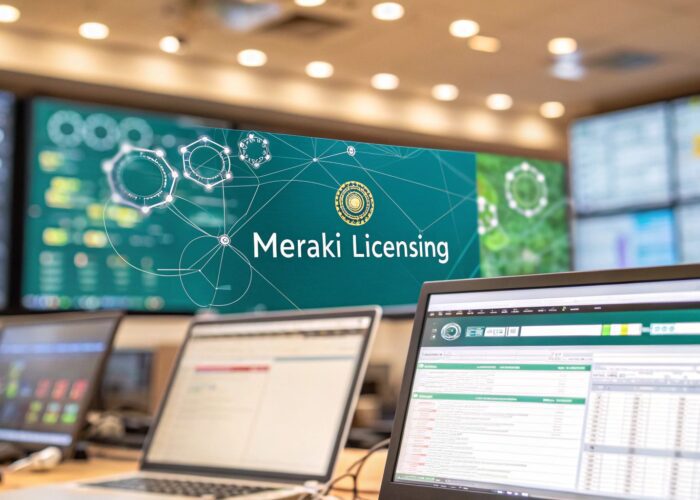
While numerous technologies are involved in helping manufacturers embrace the possibilities of Industry 4.0 — in essence, the “smart factory” — simple network management and top-notch network security are at the core of next-gen manufacturing. That’s why CIOs and COOs alike have prioritized establishing rock-solid, easy-to-manage and simple-to-scale networks.
Here a few ways deploying Cisco Meraki technology in the factory and beyond can help manufacturers drive process improvements and become more competitive.
Minimize Production Downtime
Every manufacturer recognizes the damaging impact that production downtime can have on manufacturing operations. Just a few minutes of downtime can cost large enterprises thousands or even millions of dollars, making constant uptime a key priority for decision makers in both the IT and OT departments. Meraki helps minimize downtime by simplifying remote network management, helping admins respond quickly to potential issues, and by staving off dangerous security threats.
Traditional networking infrastructure relies heavily on on-site management. And a solid network is key to preventing downtime, especially with so much production equipment being interconnected. Since maintaining an on-site IT staff at every location can be cost-prohibitive, the ability for a central IT staff to manage networks from anywhere can make a huge difference. With Meraki, admins can use real-time tools built into the dashboard, such as remote packet capture and cable testing, to identify and diagnose issues before they cause major network problems.
Additionally, as Internet-connected manufacturing equipment is increasingly embraced by IT and OT staff, a constantly updated unified threat management (UTM) system is crucial to keeping malicious cyber threats from infecting production equipment. Other features available with the Meraki solution, such as Auto-VPN and SD-WAN, help manufacturers achieve 24/7 uptime and connectivity at all sites.
Enable Mobility — Without the Headaches
In the manufacturing world, mobile technologies present an amazing opportunity to modernize production by giving plant managers and executives immediate access to real-time production information, such as production output and inventory numbers. While manufacturers absolutely should embrace these opportunities for greater information sharing and collaboration, it’s crucial to provide the right infrastructure for mobile devices. Centralized management helps ensure that devices are used to their fullest potential, without interfering with the production process. This requires deep conversations between the IT and OT departments.
Such collaboration may, for example, reveal the opportunity to integrate certain apps with production equipment. Company executives can use the resulting data to meet customer demand. Pushing the app to the right devices, configuring it correctly, and training employees on how to use the app are shared responsibilities of both departments. Meraki Systems Manager, Cisco’s enterprise mobility management (EMM) solution, can help IT seamlessly push apps and keep them updated. Systems Manager can also help manufacturers meet certain requirements for mobile device usage, whether by disabling mobile device cameras on confidential production line environments, locking devices to a single app, or preventing access to confidential data if a mobile device is taken outside of the production facility.
In many ways, manufacturers share the same opportunities and challenges as any other company when it comes to mobility. The BYOD (bring your own device) phenomenon has allowed all kinds of enterprises to make their employees more productive, even though security concerns are always present. Similarly, manufacturers can benefit heavily from enabling mobility, but using the right management tools is crucial to maximizing the benefits while minimizing the headaches.
Minimize Waste
The bane of every manufacturer’s existence is waste, whether it’s wasted time, wasted effort, or wasted materials. Even though eliminating waste entirely is a utopian ideal, the prevalence of automated machinery and other advanced technology that provides insight into production activity serves as evidence of manufacturers’ deep interest in minimizing waste. Making further progress on minimizing waste requires IT and OT to collaborate.
Why does IT-OT integration matter for waste minimization? Because waste — like many of the challenges manufacturers face — is too large of an issue for a single department to address. While waste in manufacturing occurs mainly on the OT side, expecting OT to wave a magic wand and minimize waste on its own is unrealistic in the interconnected factory of the 21st century. In fact, OT needs IT to deploy the right technology and connect the right teams with the right information to properly address waste. From a network connectivity standpoint, IT can minimize energy consumption using Meraki switches by applying schedules to certain switch ports. For instance, IT can automatically turn PoE devices off at specific times if 24/7 operation isn’t required. The aforementioned ability to centrally manage multiple networks through a single dashboard also helps prevent waste by minimizing the need for on-site maintenance.
Perhaps the most interesting application of Meraki technology in manufacturing from a waste minimization standpoint is the use of Meraki MV cameras as a sensor to intelligently monitor processes on-site. The ease of deployment and simple monitoring capabilities of the Meraki MV cameras are just the start; the cameras also allow IT and OT personnel to use motion heat maps to see movement on the factory floor and eliminate the need for an NVR (network video recorder) to save costs. Noosa Yoghurt, a leading manufacturer of yogurt in the United States, deploys the Meraki MV to mitigate product loss and help employees keep track of activities across the factory floor. (Check out Noosa’s story here.)
Closing thoughts
IT and OT may previously have been content to occupy two mindsets (and two different parts of the building), but Industry 4.0 requires that they come together to address key challenges manufacturers face today, including downtime, mobility, and waste. With Meraki technology, manufacturers can decrease costs, reduce waste, improve efficiency, and increase visibility of operations across the manufacturing plant. Ultimately, Meraki aims to simplify powerful technology and help IT focus on more strategic goals — which in manufacturing includes close collaboration with the OT team.
To learn more about how Meraki helps manufacturers, check out the Meraki for Manufacturing page.



